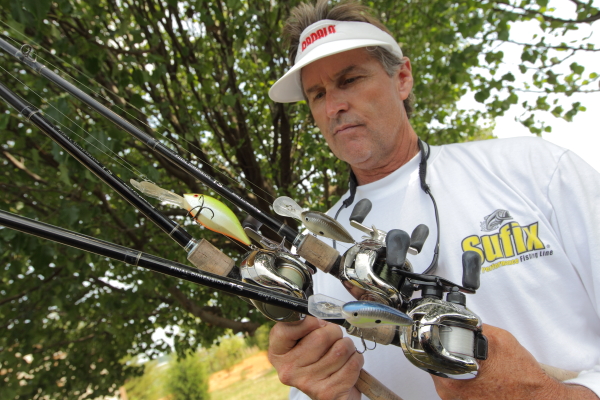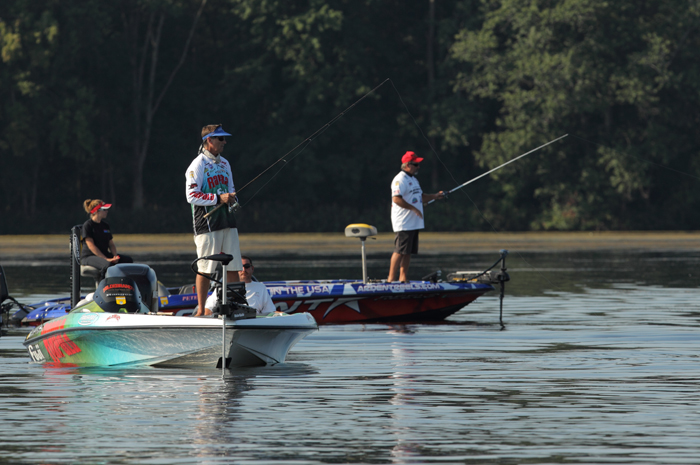Remember the old saying “Ninety percent of the fish are in 10 percent of the water”? There’s a lot of truth to it … as long as you grasp its real meaning.
It’s not suggesting that most of the fish in a given body of water are gathered in a single creek or cove. It means the vast majority can be found at the same approximate depth, relating to the same type of cover, at a given period of time.
And that is the foundation of “pattern fishing.”
Figuring out depth and cover is the key to finding fish on virtually any body of water. And it’s precisely the information any top level pro wants before heading into battle.
Time is Money
In tournament fishing, every minute counts. Whether we’re talking about practice or actual competition, time is limited. That’s why so many pros try to prepare for each event in advance. Scouting, networking and studying maps are all part of pre-tournament prep, and they can prove invaluable when trying to dissect large bodies of water.
But what do the pros do once practice begins? Where do they start?
Well, that depends largely on the pro, of course, and how well he or she has prepared for the event. Assuming they’ve done their homework, most will try to apply that info as they break down the tournament waters. Others are less structured, relying more on their instincts or intuition.
It can also depend on how well a pro knows the water. Having a strong familiarity with the water you’re competing on helps, but it’s no guarantee for success. Even a local ace with vast experience to draw from can be fooled by changing conditions.
Let’s assume they have little or no knowledge of the water. What then?
Most pros will try to go with their strengths … at least initially.Then they will factor in such things as seasonal patterns, prevailing conditions, available cover, and so on — keeping in mind that multiple patterns are likely to exist at the same time and that any of them might hold the potential to win.

That’s one reason B.A.S.S. tries to schedule tournaments on large bodies of water, so that the anglers can spread out and have some options. Kentucky Lake, Toledo Bend, Guntersville and other major waters offer lots of options because their habitat is so diverse and widespread. On big water, an angler can usually find something that will play to his or her strengths, no matter what the conditions are.
Head for Cover
Even on smaller impoundments, cover types can vary considerably. For instance, the lower end of a reservoir may be heavily developed, offering plenty of manmade cover, like docks, brushpiles, riprap and seawalls, while the upper end may feature none of these. There, you’re more likely to encounter natural targets, like flooded brush, willows and laydowns.
With options like these, which direction would you take?
Ultimately, it becomes a process of eliminating nonproductive cover — keeping in mind that multiple patterns are likely to exist.
If it’s beginning to sound complicated, it certainly can be. Now throw in the time constraints of a limited practice period and you begin to see what we’re up against.
While finding something obscure or overlooked is the goal, most pros will start on the most dominant form of cover, especially where grass is involved. Whether it grows shallow or deep, grass is a magnet for bass at just about any time of year.
If a lake or river is void of grass, they search for other dominant forms of cover, hoping to figure out which the fish are relating to. It can be a tedious search, but when they connect with the right size fish, determining depth and cover preference will usually lead to more like it.
Choose Your Weapon
While the search is underway, the pro is also in the process of fine-tuning his or her lure selection. And that, too, is a process of elimination.
It’s important to know lots of lures and techniques. When fish are shallow, for instance, it’s a safe bet most of the field will know it, and chances are you’ll be fishing behind someone. So having a few tricks up your sleeve can really pay off.
The same goes for deeper water. Although structure fish may see less pressure, they can be finicky and can quickly cool off to a particular lure or technique. So you’ll need ways to fire them up again, which plays to versatility.
Remember, lures are nothing more than tools designed to work at varying depths, in or around various types of cover and/or structure. So no matter how your selection is determined, what’s important is that it’s finely tuned and catching fish. The last thing any of us want is a bunch of randomly rigged rods piled high on the deck. That usually means you failed in practice.
Timing is Everything
OK, now let’s assume we’ve discovered a solid pattern — one that’s led to some key areas where the fish are sure to replenish. And let’s assume we have the right lure and technique for making them bite.
What happens if, for some inexplicable reason, the fish won’t cooperate? We know they’re there, but something has changed. This happens a lot, even to the pros. How they react will ultimately determine their success.
Do you change lures? Maybe. What about changing the angle of your retrieve? That might work also. Often it boils down to just one simple factor, and that’s timing.

Timing is everything. And it’s the angler who figures out the right timing who ultimately excels. That’s why many pros make brief, repeated stops on the same locations. They’re trying to hit them at the most opportune time, hoping to trigger a key fish or perhaps a whole school of fish into feeding. Some refer to it as “rhythm,” and when it’s working, there’s no better feeling.
What if a pro has no key spots to cycle through? Is it possible to remain competitive by running a pattern throughout a lake or river system? Absolutely! Pattern fishing isn’t usually restricted to just a few locations. It should work on a large scale. In fact, many big tournaments are won by anglers fishing new water each day of the event. They’re so confident in the patterns they’ve established, they “run and gun,” hitting as many similar locations as possible.
When All Else Fails
What about those times when a pattern fails completely? Well, that’s when a good back-up plan comes in. Although it may not get you to the winner’s circle, it might make the difference in cashing a check or watching from the bank. The bottom line is putting fish on the scales, regardless of what it takes.
Believe me, even the most consistent pros are sometimes lost. Their primary pattern taps out and they’re left with nothing … not even a back-up plan. In situations like these, many competitors will pick an area and just “go fishing,” throwing at anything and everything that looks good. And this sometimes works … but not very often.
Rather than fishing aimlessly down a stretch of bank, I suggest something a bit more promising. If it’s a reservoir and I have nothing figured out, I try to put myself where there’s less water and fewer distractions — like the backs of creeks or far up the main river. I know that by keeping my head down and picking these smaller areas apart, the odds of running into fish — including quality fish — are improved.
On a natural lake or river system, I may concentrate on super thick cover, fishing for resident bass.
Are these strategies guaranteed to salvage a bad day? Of course not. But they’ve bailed me out on numerous occasions.
So, next time you’re faced with an unfamiliar lake or river, do your homework ahead of time. Then, when you’re on the water, be methodical in your search. If given the chance, pattern fishing can and will work. It’s just a matter of determining the right depth and cover.





